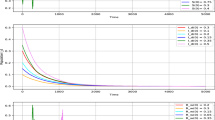Abstract
Study on double epidemics is attracting the attention of researchers in recent times to make models that are close to reality. In this paper, an epidemic model with two transmission mechanisms, Susceptible-Infected-Recovered and Susceptible-Infected-Recovered-Susceptible, is considered. The model is stochastically perturbed at transmission rates and the resulting stochastic model is examined for the existence of a positive global solution. Further, extinction, persistence and co-persistence results are studied with suitable sufficient conditions. Finally, some numerical examples are presented to support the theoretical results established.






Similar content being viewed by others
References
Martcheva, M. 2015. An Introduction to Mathematical Epidemiology, vol. 61. Berlin: Springer.
Cui, J., Y. Sun, and H. Zhu. 2008. The impact of media on the control of infectious diseases. Journal of Dynamics and Differential Equations 20: 31–53.
Hattaf, K., N. Yousfi, and A. Tridane. 2012. Mathematical virus dynamics model with general incidence rate and cure rate. Nonlinear Analysis Real World Applications 13: 1866–1872. https://doi.org/10.1016/j.nonrwa.2011.12.015.
Lahrouz, A., L. Omari, D. Kiouach, and A. Belmaâti. 2012. Complete global stability for an SIRS epidemic model with generalized non-linear incidence and vaccination. Applied Mathematics and Computation 218(11): 6519–6525.
Li, G., and J. Zhen. 2005. Global stability of an SEI epidemic model with general contact rate. Chaos, Solitons and Fractals 23: 997–1004.
M’Kendrick, A. 1925. Applications of mathematics to medical problems. Proceedings of the Edinburgh Mathematical Society 44: 98–130.
Jacquez, J.A. 1987. A note on chain-binomial models of epidemic spread: What is wrong with the reed-frost formulation? Mathematical Biosciences 87(1): 73–82.
Bartlett, M. 1949. Some evolutionary stochastic processes. Journal of the Royal Statistical Society. Series B (Methodological) 11(2): 211–229.
Meng, X., Z. Li, and X. Wang. 2010. Dynamics of a novel nonlinear SIR model with double epidemic hypothesis and impulsive effects. Nonlinear Dynamics 59(3): 503–513.
Abbas, S., and M. Banerjee. 2010. Stochastically perturbed allelopathic phytoplankton model. Electronic Journal of Differential Equations (EJDE) 98: 1–15.
Miao, A., X. Wang, T. Zhang, W. Wang, and B. Sampath Aruna Pradeep. 2017. Dynamical analysis of a stochastic SIS epidemic model with nonlinear incidence rate and double epidemic hypothesis. Advances in Difference Equations 1: 1–27.
Qi, H., L. Liu, and X. Meng. 2017. Dynamics of a nonautonomous stochastic SIS epidemic model with double epidemic hypothesis. Complexity 2017: 4861391.
Zhang, X., D. Jiang, T. Hayat, and B. Ahmad. 2017. Dynamics of a stochastic SIS model with double epidemic diseases driven by Lévy jumps. Physica A: Statistical Mechanics and its Applications 471: 767–777.
Abbas, S., M. Niezabitowski, and S.R. Grace. 2021. Global existence and stability of Nicholson blowflies model with harvesting and random effect. Nonlinear Dynamics 103: 2109–2123.
Ng, T.W., G. Turinici, and A. Danchin. 2003. A double epidemic model for the SARS propagation. BMC Infectious Diseases 3(1): 1–16.
Chang, Z., X. Meng, and X. Lu. 2017. Analysis of a novel stochastic SIRS epidemic model with two different saturated incidence rates. Physica A: Statistical Mechanics and its Applications 472: 103–116.
Meng, X., S. Zhao, T. Feng, and T. Zhang. 2016. Dynamics of a novel nonlinear stochastic SIS epidemic model with double epidemic hypothesis. Journal of Mathematical Analysis and Applications 433(1): 227–242.
Boukanjime, B., M. El Fatini, A. Laaribi, and R. Taki. 2019. Analysis of a deterministic and a stochastic epidemic model with two distinct epidemics hypothesis. Physica A: Statistical Mechanics and its Applications 534: 122321.
Selvan, T.T., and M. Kumar. 2023. Dynamics of a deterministic and a stochastic epidemic model combined with two distinct transmission mechanisms and saturated incidence rate. Physica A: Statistical Mechanics and its Applications 619: 128741.
Mao, X. 2007. Stochastic Differential Equations and Applications. Amsterdam: Elsevier.
Liptser, R.S. 1980. A strong law of large numbers for local martingales. Stochastics 3(1–4): 217–228.
Ji, C., and D. Jiang. 2014. Threshold behaviour of a stochastic SIR model. Applied Mathematical Modelling 38(21–22): 5067–5079.
Author information
Authors and Affiliations
Contributions
All the authors contributed equally to the preparation of the present paper.
Corresponding author
Ethics declarations
Conflict of interest
The authors declare that they do not have any competing interests.
Ethics approval
This article does not contain any studies with human participants or animals performed by any of the authors.
Additional information
Communicated by S. Ponnusamy.
Publisher's Note
Springer Nature remains neutral with regard to jurisdictional claims in published maps and institutional affiliations.
Rights and permissions
Springer Nature or its licensor (e.g. a society or other partner) holds exclusive rights to this article under a publishing agreement with the author(s) or other rightsholder(s); author self-archiving of the accepted manuscript version of this article is solely governed by the terms of such publishing agreement and applicable law.
About this article
Cite this article
Tamil Selvan, T., Kumar, M. Analysis of a stochastic epidemic model driven by bilinear incidence rate with two different transmission mechanisms. J Anal 32, 509–527 (2024). https://doi.org/10.1007/s41478-023-00665-5
Received:
Accepted:
Published:
Issue Date:
DOI: https://doi.org/10.1007/s41478-023-00665-5




